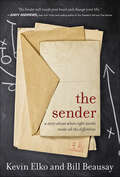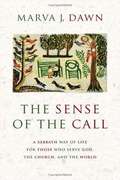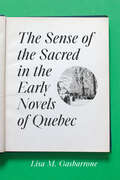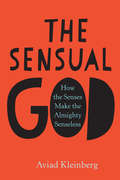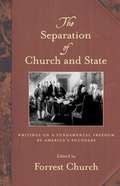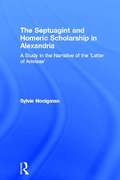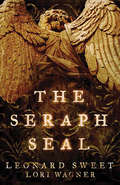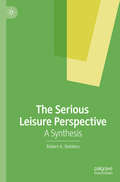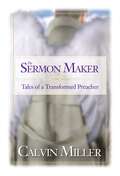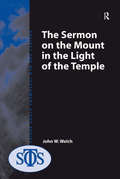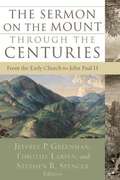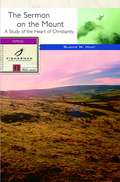- Table View
- List View
The Seminary Student Writes
by Deborah CoreDeborah Core offers practical guidance for beginning seminary students who feel overwhelmed and under-prepared to write the number and quality of papers their courses require. The book begins with reflections on writing as a sacred action, then addresses such practical matters as choosing and researching a topic; outlining, drafting, and polishing a paper; and using the proper format for footnotes and bibliography. Also included are sample papers in MLA and Chicago styles and an overview of grammar and usage.
The Senator's Darkest Days
by Joan E. Histon40AD and despite the threat of bloodshed, Senator Vivius Marcianus travels to Jerusalem to investigate the delay in erecting the Emperor's statue in the temple. Failure is not an option. When Vivius is wounded and imprisoned, it is left to Dorio to rescue his heavily pregnant sister and her children and set about proving Vivius's innocence. The thrilling sequel to The Senator's Assignment
The Senator's Other Daughter (The Belles of Lordsburg #1)
by Stephen BlyWithin the locket hanging near her heart is the secret that's broken it. A life of peace and seclusion as the unknown Miss Denison. It's what Grace longed for even before her father banished her from Washington, D.C. She just may have found it in Lordsburg, New Mexico--the small railroad town where people hide until the world stops looking. A place to send black sheep, skeletons in the closet, rebellious sons ... and wayward daughters whose secrets could ruin a father's precious political career. Yet Grace's cherished anonymity is soon lost when she gets caught in the middle of a huge ruckus. And her life is anything but peaceful thanks to an ornery pet at her boarding house, a precocious young Mexican boy, and a cowboy who makes her want to run to him and from him at the same time. When he learns the secret within her locket, will he break her heart too?
The Sender Companion Journal: Be a Blessing and Other Lessons from The Sender
by Bill Beausay Dr Kevin ElkoThe Sender was inspired by real letters sent to a real person. Here are thirty-one of those letters, including many that were not included in The Sender. The powerful life-changing words of hope, encouragement, and empowerment are now available in daily readings with guided journaling so you can learn and live the message that is changing lives.
The Sender: A Story About When Right Words Make All The Difference
by Kevin Elko Bill BeusaySometimes the right words make all the differenceA few months ago he was a high school football coach. Now Charlie Cristo is a cancer patient, battling not only an aggressive disease but also years of bitterness and disappointment. Then anonymous letters start arriving from a source known only as The Sender. Lift your spirits. Work the process. Help one another. The short, wise counsel in the letters challenged Charlie Cristo to fight the disease ravaging his body and the anger threatening his soul. What will you do with The Sender's advice?
The Sense Of Sight In Rabbinic Culture
by Rachel NeisThis book studies the significance of sight in rabbinic cultures across Palestine and Mesopotamia (approximately first to seventh centuries). It tracks the extent and effect to which the rabbis living in the Greco-Roman and Persian worlds sought to appropriate, recast and discipline contemporaneous understandings of sight. Sight had a crucial role to play in the realms of divinity, sexuality and gender, idolatry and, ultimately, rabbinic subjectivity. The rabbis lived in a world in which the eyes were at once potent and vulnerable: eyes were thought to touch objects of vision, while also acting as an entryway into the viewer. Rabbis, Romans, Zoroastrians, Christians and others were all concerned with the protection and exploitation of vision. Employing many different sources, Professor Neis considers how the rabbis engaged varieties of late antique visualities, along with rabbinic narrative, exegetical and legal strategies, as part of an effort to cultivate and mark a 'rabbinic eye'.
The Sense of Creation: Experience and the God Beyond (Routledge Philosophy of Religion Series)
by Patrick MastersonWhat kind of experience might help to confirm and make sense of the puzzling belief in divine creation, so central to the main monotheistic religions? Anselm and Aquinas developed a philosophical understanding of 'Creation' as an asymmetrical relationship between the world and God, that is, that the world is really related to God in a relationship of total dependence but God is in no way really related to or modified by this created world. This idea of an asymmetrical relationship is the key concept unifying all aspects of this book which discusses the three main inter-related questions in a philosophical discussion about God -- the question of meaning, the question of existence, and the question of co-existence. The book explores various 'ciphers' of this asymmetrical relationship in our pre-philosophical lived experience. These are experiences such as that of the relationship between our knowledge and what we know, or our sense of obligation to our vulnerable neighbour. It argues that deciphering such experiences helps to make sense of the 'asymmetrical' relation of creation and that it in turn makes sense of them. Masterson argues further that this idea of asymmetrical relationship provides insight into the main questions of philosophy of religion and is an illuminating source of critical dialogue with contemporary Anglo/American and Phenomenological approaches in philosophy of religion.
The Sense of the Call: A Sabbath Way of Life for Those Who Serve God, the Church, and the World
by Marva J. DawnWhy is it "so hard" to serve God these days? Church workers suffer from low morale, while Christians of all stripes struggle to find their way in a culture fixated on sexuality, violence, and wealth. In "Keeping the Sabbath Wholly," Marva Dawn introduced the vital Sabbath aspects of "resting, ceasing, feasting, "and "embracing. " Now, in "The Sense of the Call," she expands these into a way of life for serving God and the Kingdom every single day of the week. A Sabbath way of life, Dawn asserts, consists of "resting" in the Kingdom's grace, "ceasing" by grace attitudes and actions that hinder the Kingdom, "feasting" so as to radiate the gracefull splendor of the Kingdom, and "embracing" the Kingdom's gracious purposes. To this end, Dawn teaches skills such as learning to rest in prayer, saying no to busyness, enjoying the body, and embracing the cost of living as a Christian disciple. Frank yet compassionate, "The Sense of The Call" will guide all who serve, whether in the Church or world into a more restful, joy-full life of trust in God.
The Sense of the Sacred in the Early Novels of Quebec
by Lisa M. GasbarroneQuebec’s early novels are full of sacred themes and motifs – devotional objects and practices, parables and scripture, priests and nuns, transcendence, divinity, and eternity. Yet the critical gaze of the past fifty years has seldom engaged the idea of the sacred in a sustained way. Indeed the presence of the sacred has alienated modern and postmodern readers who ignore or downplay its significance, leading to misguided assessments of these works as mediocre and even unreadable for contemporary audiences.The Sense of the Sacred in the Early Novels of Quebec reexamines seven classic novels at the foundations of Quebec’s national literature: Patrice Lacombe’s La Terre paternelle (1846), P.-J.-O. Chauveau’s Charles Guérin (1853), Antoine Gérin-Lajoie’s Jean Rivard (1874), Philippe Aubert de Gaspé’s Les Anciens Canadiens (1863), Laure Conan’s Angéline de Montbrun (1884), Louis Hémon’s Maria Chapdelaine (1916), and Félix-Antoine Savard’s Menaud, maître-draveur (1937). Through chapters that focus on sacred themes, character analysis, narrative temporalities, and the hermeneutics of the sacred, Lisa Gasbarrone demonstrates that these novels are more nuanced and innovative than their reputation has allowed.*The Sense of the Sacred in the Early Novels of Quebec *reintroduces readers to classic works of French-Canadian literature that ironically and provocatively cast their quarrel with modernity in that essentially modern form: the novel.
The Sensual God: How the Senses Make the Almighty Senseless
by Aviad KleinbergIn the Old Testament, God wrestles with a man (and loses). In the Talmud, God wriggles his toes to make thunder and takes human form to shave the king of Assyria. In the New Testament, God is made flesh and dwells among humans. For religious thinkers trained in Greek philosophy and its deep distaste for matter, sacred scripture can be distressing. A philosophically respectable God should be untainted by sensuality, yet the God of sacred texts is often embarrassingly sensual.Setting experts' minds at ease was neither easy nor simple, and often faith and logic were stretched to their limits. Focusing on examples from both Christian and Jewish sources, from the Bible to sources from the Late Middle Ages, Aviad Kleinberg examines the way Christian and Jewish philosophers, exegetes, and theologians attempted to reconcile God's supposed ineffability with numerous biblical and postbiblical accounts of seeing, hearing, smelling, touching, and even tasting the almighty. The conceptual entanglements ensnaring religious thinkers, and the strange, ingenious solutions they used to extricate themselves, tell us something profound about human needs and divine attributes, about faith, hope, and cognitive dissonance.
The Separation of Church and State: Writings on a Fundamental Freedom by America's Founders
by Forrest Church[From the book jacket] Americans will never stop debating the question of church-state separation. Courts across the country perpetually hear cases on religion's place in our schools, civic government, and society at large. Such debates lead us back to the nation's beginnings and the founders' intent. The Separation of Church and State presents, for the first time, a basic collection of the founders' teachings on this topic. Readers can see for themselves why George Washington, Thomas Jefferson, and James Madison-together with leading evangelical Christians of the day-believed passionately in church-state separation. This concise primer gets past the rhetoric that surrounds the current debate, placing the founders' vivid writings on religious liberty in historical perspective.
The Separation of Church and State: Writings on a Fundamental Freedom by America's Founders
by Forrest ChurchAmericans will never stop debating the question of church-state separation, and such debates invariably lead back to the nation's beginnings and the founders' intent. The Separation of Church and State presents a basic collection of the founders' teachings on this topic. This concise primer gets past the rhetoric that surrounds the current debate, placing the founders' vivid writings on religious liberty in historical perspective. Edited and with running commentary by Forrest Church, this important collection informs anyone curious about the original blueprint for our country and its government.
The Sephardic Atlantic: Colonial Histories and Postcolonial Perspectives
by Jonathan Schorsch Sina RauschenbachThis volume contributes to the growing field of Early Modern Jewish Atlantic History, while stimulating new discussions at the interface between Jewish Studies and Postcolonial Studies. It is a collection of substantive, sophisticated and variegated essays, combining case studies with theoretical reflections, organized into three sections: race and blood, metropoles and colonies, and history and memory. Twelve chapters treat converso slave traders, race and early Afro-Portuguese relations in West Africa, Sephardim and people of color in nineteenth-century Curaçao, Portuguese converso/Sephardic imperialist behavior, Caspar Barlaeus’ attitude toward Jews in the Sephardic Atlantic, Jewish-Creole historiography in eighteenth-century Suriname, Savannah’s eighteenth-century Sephardic community in an Altantic setting, Freemasonry and Sephardim in the British Empire, the figure of Columbus in popular literature about the Caribbean, key works of Caribbean postcolonial literature on Sephardim, the holocaust, slavery and race, Canadian Jewish identity in the reception history of Esther Brandeau/Jacques La Fargue and Moroccan-Jewish memories of a sixteenth-century Portuguese military defeat.
The Sephardim of England: A History of the Spanish and Portuguese Jewish Community 1492-1951 (Routledge Library Editions: Jewish History and Identity)
by Albert M. HyamsonOriginally published in 1951, this book explores the development in England of the Sephardi branch of the Jewish community, the co-heirs, with their kinsmen in Holland, in Italy, in North America and in the Middle East, of the Golden Age of Jewish history in Spain. Based on archival history from within the community, it was the first full-length history of the Sephardi community in England and describes how this little Jewish community, the first in England since the Middle Ages, grew, prospered and contributed the wealth and influence of London, and eventually producing in Disraeli one of England’s greatest Prime Ministers.
The Septuagint and Homeric Scholarship in Alexandria: A Study in the Narrative of the 'Letter of Aristeas'
by Sylvie HonigmanThe Letter of Aristeas tells the story of how Ptolemy Philadelphus of Egypt commissioned seventy scholars to translate the Hebrew Bible into Greek. Long accepted as a straightforward historical account of a cultural enterprise in Ptolemaic Alexandria, the Letter nevertheless poses serious interpretative problems. Sylvie Honigman argues that the Letter should not be regarded as history, but as a charter myth for diaspora Judaism. She expounds its generic affinities with other works on Jewish history from Ptolemaic Alexandria, and argues that the process of translation was simultaneously a process of establishing an authoritative text, comparable to the work on the text of Homer being carried out by contemporary Greek scholars.The Letter of Aristeas is among the most intriguing literary productions of Ptolemaic Alexandria, and this is the first book-length study to be devoted to it.
The Seraph Seal
by Leonard Sweet Lori Wagner2012: An ancient prophecy quietly unfolds as a fragmenting world accelerates its descent into massive chaos.Then, in 2048, the prophecy comes to fruition. US president Matthew Serafino is sworn into office, and University of Virginia historian Paul Binder receives a cryptic but summoning message. Strange circumstances and bizarre discoveries lead Paul to London, where he meets a brilliant and beautiful manuscript specialist, Angela Matthews Krall, in order to decipher an unknown Syrian manuscript with special powers. Together, they uncover clues that lead them both down a mysterious, life-or-death path.Global intrigue, cascading natural catastrophes, and a complexity of characters, motives, and symbolic traditions intersect as Paul and Angela delve into forgotten traditions and lost meanings. Life-changing discoveries force them to struggle with questions about their own faith and the nature of truth and hope. Suddenly they find themselves positioned either to lead humanity into a new future or to watch as the earth dissolves into total destruction. The Seraph Seal combines apocalyptic intrigue with a journey of love and discovery that blurs the lines between fact and fiction. It will lead you into a world where only you can determine the future of the earth as we know it.
The Serious Leisure Perspective: A Synthesis
by Robert A. StebbinsThe Serious Leisure Perspective (SLP) is a theoretic framework developed by Robert A. Stebbins in 1973, that brings together three main forms of leisure known as serious leisure, casual leisure, and project-based leisure. The SLP has evolved considerably since 1973, and this textbook provides a synthesis of the many concepts and propositions, as well as the data supporting them. In this overview, Stebbins organizes the entire framework along conceptual lines, with careful attention to level of empirical support and validation of each concept, presenting an up-to-date version of the SLP that allows interested students and researchers of social psychology, sociology, and leisure studies, to pinpoint exact elements of the theory, the empirical base and its application.
The Sermon Maker: Tales of a Transformed Preacher
by Calvin MillerThree contemporary, humorous parables of a preacher who struggles with his need to change Sam the preacher wonders what has gone wrong with his sermons. Are people still listening? Well-known storyteller and communications professor Calvin Miller combines his fiction writing with his insight into preaching to address the changes faced by today’s preachers, especially the fact that contemporary congregations have shifted to a different way of listening. How can Sam recover his passion for preaching? In this short, entertaining, story-driven book, church leaders will see honest reflections of themselves. But the narrative humor also provides a clever way to stimulate thought and discussion on how preachers and preaching are changing. Some places in the story will lead to laughter, others will cause readers to pause and reflect. But whatever the reaction, The Sermon Maker leaves the reader encouraged and changed. Extensive commentary on the stories provides insight from the author into the best ways to communicate. Just as the story in the tremendously popular Who Moved My Cheese? impacted readers in the business world who were facing change, so this book is designed as a quick but stimulating story for any church leader who preaches or is concerned about the state of preaching today.
The Sermon Sucking Black Hole: Why You Can't Remember on Monday What Your Minister Preached on Sunday (Morgan James Faith Ser.)
by David R. MainsVery little communication takes place between most pastors/priests and their congregants regarding the weekly sermon/homily. This lack of constructive dialogue has resulted in Sunday messages that are not only out-of-touch with where parishioners are living, but for the most part what&’s said isn&’t remembered much beyond the church parking lot. Dr. Mains contends that people in the pew can best judge when a sermon is helpful to them and when it isn&’t. So why not include them in the process of both preparing and evaluating sermons? Not preaching the sermons. . . . .but again, preparing and evaluating them. He makes these changes sound so simple and practical that you can&’t help but wonder, &“Why weren&’t these ideas implemented years ago?&”Most people in the pew don&’t realize how integral they are to finding a solution to this problem. But the pulpit/pew combination can be an incredibly powerful team, so let&’s begin to work together to help solve this mystery of what&’s happening to sermons.This is not a negative book or one that only points out problems. Instead, it&’s a positive, practical and encouraging read that should fill you with hope for not only your local congregation, but churches everywhere.
The Sermon on the Mount
by Emmet FoxWhat did Jesus teach? Distilled from years of study and lecture, affirmed by nearly a million readers over the last fifty years, Emmet Fox's answer in The Sermon on the Mount is simple. The Bible is a "textbook of metaphysics" and the teachings of Jesus express--without dogma--a practical approach for the development of the soul and for the shaping of our lives into what we really wish them to be. For Fox, Jesus was "no sentimental dreamer, no mere dealer in empty platitudes, but the unflinching realist that only a great mystic can be." In his most popular work, Emmet Fox shows how to: Understand the true nature of divine wisdom. Tap into the power of prayer. Develop a completely integrated and fully expressed personality. Transform negative attitudes into life-affirming beliefs. Claim our divine right to the full abundance of life.
The Sermon on the Mount
by Emmet FoxWhat did Jesus teach? Distilled from years of study and lecture, affirmed by nearly a million readers over the last fifty years, Emmet Fox's answer in The Sermon on the Mount is simple. The Bible is a "textbook of metaphysics" and the teachings of Jesus express--without dogma--a practical approach for the development of the soul and for the shaping of our lives into what we really wish them to be. For Fox, Jesus was "no sentimental dreamer, no mere dealer in empty platitudes, but the unflinching realist that only a great mystic can be."In his most popular work, Emmet Fox shows how to: Understand the true nature of divine wisdom. Tap into the power of prayer. Develop a completely integrated and fully expressed personality. Transform negative attitudes into life-affirming beliefs. Claim our divine right to the full abundance of life.
The Sermon on the Mount and Moral Theology: A Virtue Perspective
by Mattison William C. IIIIn this volume, William C. Mattison, III demonstrates that virtue ethics provides a helpful key for unlocking the moral wisdom of the Sermon on the Mount. Showing how familiar texts such as the Beatitudes and Petitions of the Lord's Prayer are more richly understood, and can even be aligned with the theological and cardinal virtues, he also locates in the Sermon classic topics in morality, such as the nature of happiness, intentionality, the intelligibility of human action, and the development of virtue. Yet far from merely placing the teaching of Aristotle in the mouth of Jesus, he demonstrates how the Sermon presents an account of happiness and virtue transformed in the light of Christian faith. The happiness portrayed is that of the Kingdom of heaven, and the habits needed to participate in it in the next life, but even initially in this one, are possible only by God's grace through Jesus Christ, and lived in the community that is the Church.
The Sermon on the Mount in the Light of the Temple (Society For Old Testament Study Ser.)
by John W. WelchNo religious text has influenced the world more than has the New Testament's Sermon on the Mount, and yet this crucial text still begs to be more clearly understood. Why was it written? What unifying theme or purpose holds it all together? Should it be called a sermon? Or is it some other kind of composition? How would its earliest listeners have heard its encoded allusions and systematic program? This book offers new insights into the Sermon on the Mount by seeing it in the shadow of the all-pervasive Temple in Jerusalem, which dominated the religious landscape of the world of Jesus and his earliest disciples. Analyzing Matthew 5-7 in light of biblical and Jewish backgrounds, ritual studies, and oral performances in early Christian worship, this reading coherently integrates every line in the Sermon. It positions the Sermon as the premier Christian mystery.
The Sermon on the Mount through the Centuries
by Stephen R. Spencer Jeffrey P. Greenman Timothy LarsenThe Sermon on the Mount through the Centuries offers an engaging approach to the study of historical theology and biblical exegesis. Stellar contributing scholars examine various interpretative approaches to the Sermon on the Mount, providing glimpses into historical perspectives on a passage that distills the very essence of the teaching of Jesus.
The Sermon on the Mount: A Radical Way of Being God's People (Fisherman Bible Studyguide Series)
by Gladys HuntIn these Bible studies, Gladys Hunt looks at the Sermon on the Mount, showing how Jesus' message encapsulates all of New Testament teaching on how to live the Christian life.




